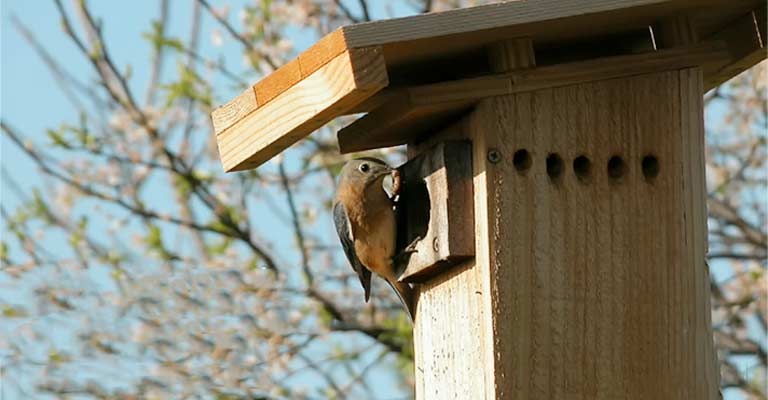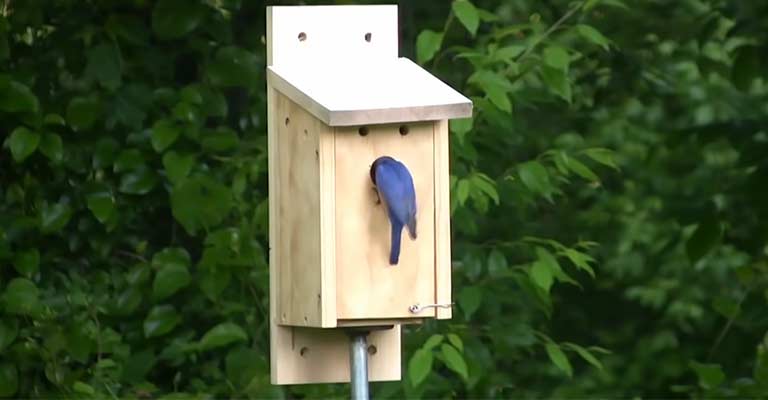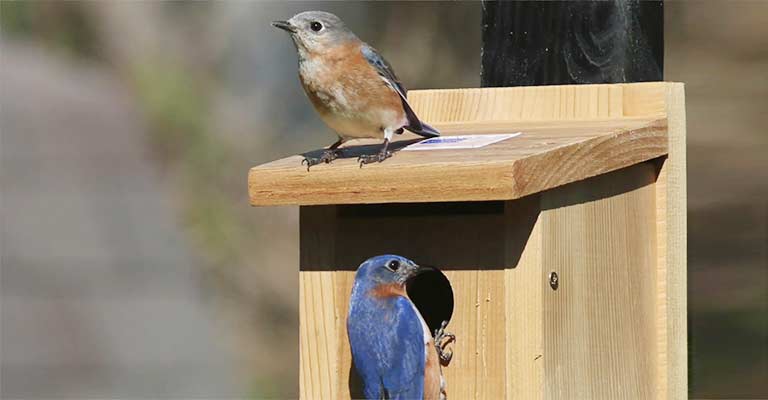Creating a welcoming environment for bluebirds involves more than just providing a cozy house. Bluebird house placement is a critical factor that significantly influences the success of attracting and supporting these charming avian residents.
In this guide, we’ll delve into the art and science of positioning bluebird houses to maximize their appeal to these delightful birds.
Bluebirds are not just aesthetically pleasing; they also play a crucial role in maintaining ecological balance by controlling insect populations. Understanding their habitat preferences and adapting our strategies accordingly is essential.
From choosing the right location to considering environmental factors, this guide will walk you through the nuances of bluebird house placement, ensuring that your efforts result in a thriving bluebird haven.
Whether you’re a seasoned bird enthusiast or a novice looking to contribute to local biodiversity, mastering the art of bluebird house placement is a rewarding endeavor.

Bluebird House Placement: Creating the Ideal Habitat for Bluebirds
Providing bluebirds with suitable nesting spaces is a rewarding endeavor, and one crucial aspect of this effort is the strategic placement of bluebird houses.
Here, we’ll explore the key considerations and step-by-step instructions to ensure your bluebird houses become sought-after homes for these charming avians.
Understanding Bluebird Behavior
Before delving into the specifics of placement, it’s essential to comprehend bluebird behavior. Bluebirds prefer open habitats with short grass, as they primarily feed on insects found on the ground.
They are also cavity-nesting birds, making them ideal candidates for nesting boxes. Knowing these traits guides us in creating an environment that mirrors our natural preferences.
Choosing the Right Bluebird House
Selecting an appropriate bluebird house is the first step. Opt for houses with an entrance hole of 1.5 inches in diameter to deter larger birds.
The box should also be well-ventilated, with drainage holes to prevent water accumulation. Installing a predator guard can further enhance the safety of the nesting site.
Placing the bluebird house facing east or northeast serves as a protective measure against direct sunlight and prevailing winds. This orientation shields the entrance from harsh weather conditions, creating a comfortable haven for fledglings to thrive in.
The morning sun from the east provides warmth without the intensity of afternoon rays, and the northeast orientation helps shield the entrance from prevailing winds.
This thoughtful placement ensures that the interior remains conducive for nesting even during varying weather conditions. Here are some other aspects:
Height
Mounting the house on a post or pole, positioned 4 to 6 feet above the ground, is a strategic choice. This height minimizes the risk of predators reaching the nest while facilitating convenient monitoring for bird enthusiasts.
Elevating the bluebird house to this specific height not only deters ground-based predators but also allows for easy observation.
Birdwatchers can appreciate the nesting behaviors without causing unnecessary disturbance, fostering a harmonious coexistence between humans and bluebirds.
Clear Flight Path
Ensuring an unobstructed flight path to the entrance is essential. Bluebirds appreciate a clear approach, aiding in their navigation to and from the nest.
A clear flight path reduces stress for bluebirds during their comings and goings. It enhances their overall nesting experience and contributes to a safer environment, especially during crucial times like feeding and fledgling stages.
Distance Between Houses

When installing multiple bluebird houses, maintaining a minimum distance of 100 yards is crucial. Bluebirds are territorial, and ensuring adequate space helps reduce competition and territorial disputes.
Respecting the territorial nature of bluebirds is fundamental to successful nesting. This spacing minimizes conflicts, allowing each nesting pair to establish and defend their territory effectively, contributing to a more harmonious bluebird community.
Surrounding Vegetation
While bluebirds prefer open spaces, it’s essential to strike a balance. Avoid dense vegetation around the house while providing a nearby perch, such as a branch or wire, for them to survey their surroundings and identify potential threats.
The careful balance of open space and a nearby perch caters to the bluebird’s need for security and surveillance. It ensures that they can easily spot predators while having a vantage point to observe their surroundings, reinforcing their sense of safety.
In crafting the perfect environment for bluebirds, thoughtful consideration of these placement factors not only attracts them to your space but also contributes to their well-being and the preservation of their species.
Environmental Considerations
Beyond the physical structure, the surroundings play a pivotal role in creating an ideal nesting haven for bluebirds. Environmental considerations, ranging from sunlight exposure to predator management and proximity to water sources, significantly impact their well-being.
Let’s delve into these crucial factors for optimal bluebird habitat.
Sunlight h4
Bluebirds thrive in moderate temperatures, making sunlight exposure a critical consideration. Optimal placement involves choosing a location with morning sunlight and afternoon shade to regulate the internal temperature of the nest, fostering a consistently comfortable environment.
Morning sunlight provides the necessary warmth for nesting activities without subjecting the interior to the intensity of afternoon heat. Afternoon shade prevents overheating during warmer periods, creating a microclimate within the nest that aligns with the bluebird’s preferences.
Predator Management
Safeguarding the nest from climbing predators like snakes or raccoons is paramount. Implementing predator deterrents, such as baffles or cones, is an effective strategy. Regular monitoring and maintenance of these deterrents ensure continued protection for the nesting bluebirds.
The implementation of predator deterrents is a proactive measure to create a secure environment for bluebirds.
Regular checks and maintenance not only prevent potential threats but also demonstrate a commitment to providing a safe habitat, fostering an environment conducive to successful nesting and fledgling stages.
Proximity to Water
While bluebirds don’t nest near water sources, having a water feature nearby offers significant benefits during the nesting season.
Ensuring a clean and reliable water supply for both drinking and bathing contributes to the overall well-being of bluebirds.
The availability of water near the nesting site is advantageous for bluebirds, especially during the demanding nesting season.
It supports their hydration needs and provides an opportunity for bathing, promoting feather health. A reliable water source in proximity enhances the overall attractiveness of the habitat.
In considering these environmental factors, we not only cater to the physical needs of bluebirds but also contribute to the creation of a habitat that aligns with their natural behaviors and preferences.
A well-thought-out environment ensures that bluebirds not only survive but thrive, fostering a harmonious coexistence between these charming avians and the carefully curated surroundings.
How to Monitor and Maintain A Bluebird Nesting Box?

To ensure the well-being of the resident bluebirds and increase the likelihood of successful nesting, regular monitoring and maintenance are essential components. Here’s a comprehensive guide to help you navigate this fulfilling responsibility.
Regular Checks
Frequent inspections of the bluebird nesting box are crucial for staying informed about the progress of nesting activities. Begin by observing the box from a distance to avoid unnecessary disturbance.
Use binoculars to assess the behavior of adult bluebirds around the box, noting any signs of nesting, feeding, or territorial behavior.
Entry Hole Monitoring
Keep an eye on the entry hole to gauge the frequency of visits by bluebirds. If the entry hole remains consistently clean, it indicates ongoing activity. However, sudden changes, such as a lack of activity, may warrant closer inspection to identify potential issues.
Nesting Material
During the breeding season, bluebirds diligently gather nesting materials. Periodically check the interior of the box to ensure an ample supply of nesting material, such as grass, twigs, and feathers.
If the material appears sparse or depleted, consider providing additional nesting material nearby to support their efforts.
Nest Inspection
Once nesting is underway, exercise caution while inspecting the nest. Gently lift the box lid or carefully peek inside to assess the condition of the eggs or chicks. Avoid excessive handling, as it can cause stress to the birds and potentially lead to nest abandonment.
Cleaning Procedures
After each brood has fledged, it’s essential to clean the nesting box thoroughly. Remove old nesting material to prevent the buildup of parasites and pathogens. Use gloves and follow sanitary practices during cleaning to ensure a safe environment for future occupants.
Disinfection
To maintain a hygienic environment, disinfect the interior of the nesting box. A mild bleach solution is suitable for this purpose. Ensure the box is thoroughly dry before allowing bluebirds to reoccupy it.
This step is crucial in preventing the transmission of diseases and promoting a healthy nesting space.
Predator Deterrents
Check and maintain any predator deterrents you’ve implemented, such as baffles or cones. Ensure they are secure and functioning correctly to protect the nest from potential threats like snakes or raccoons.
Regularly monitoring these deterrents is an ongoing task to guarantee continuous protection.
Record-Keeping
Maintain a simple record of your observations. Note the dates of nest initiation, egg laying, hatching, and fledging. This information can be valuable for tracking patterns and understanding the nesting behaviors of bluebirds in your area.
Extended Monitoring
Continue monitoring the bluebird nesting box throughout the year, even outside the breeding season. Bluebirds may use the box for roosting during colder months, and periodic checks help ensure its structural integrity and readiness for the upcoming breeding season.
FAQs
How do I attract bluebirds to my nesting box?
To attract bluebirds, provide a suitable nesting box with a 1.5-inch entrance hole. Place it facing east or northeast, 4 to 6 feet above the ground, in an open area with minimal vegetation.
How can I prevent predators from accessing the bluebird nesting box?
Implement predator deterrents such as baffles or cones on the post supporting the nesting box. Ensure they are secure and regularly monitored. This helps safeguard the nest from climbing predators like snakes or raccoons.
When is the best time to clean the bluebird nesting box?
Clean the nesting box after each brood has fledged. Remove old nesting material to prevent parasites and diseases. Use gloves during cleaning and disinfect the interior with a mild bleach solution. This maintains a hygienic environment for future occupants.
What should I do if I find abandoned bluebird eggs or chicks?
If you suspect abandonment, observe from a distance for a reasonable period to confirm. If abandonment is evident, refrain from disturbing the nest. If necessary, consult local wildlife experts or rehabilitators for guidance on appropriate interventions.
Can I move a bluebird nesting box once it’s installed?
It’s best to avoid moving a bluebird nesting box once occupied, as this can lead to nest abandonment. If a change is necessary, do so during the offseason to minimize disruption. Ensure the new location meets their preferences, including height, orientation, and clear flight path.
Conclusion
The success of attracting bluebirds to your backyard rests on the careful consideration of their habitat needs. By adhering to the guidelines outlined in this guide, you can create an ideal environment that encourages bluebirds to make your space their home.
Whether you’re a dedicated birdwatcher or someone passionate about fostering biodiversity, providing the right conditions for bluebirds is a fulfilling endeavor.
As you embark on this journey, take joy in the prospect of witnessing these vibrant creatures flourish in a space that you’ve thoughtfully tailored to their needs.
By recognizing the significance of bluebird house placement and making informed choices, you contribute not only to the well-being of these charming birds but also to the broader ecological balance.
Your efforts can ripple through the ecosystem, creating a haven for bluebirds and fostering a deeper connection with the natural world right in your backyard.